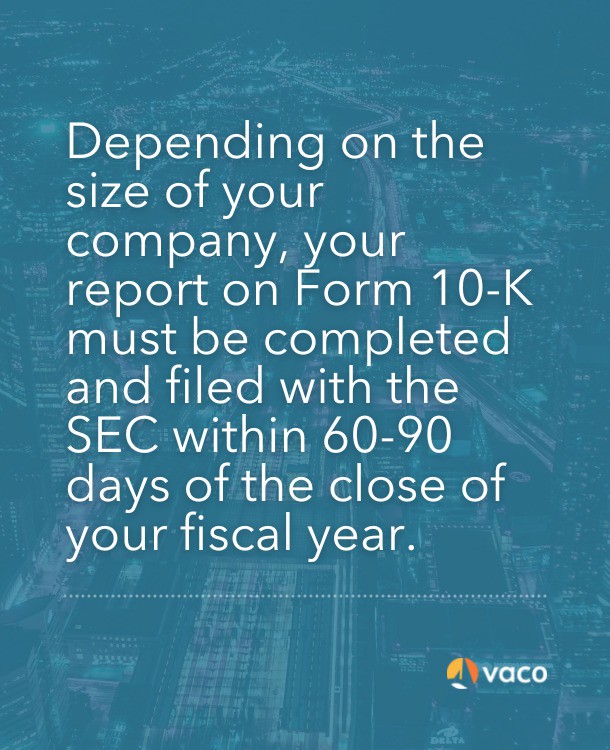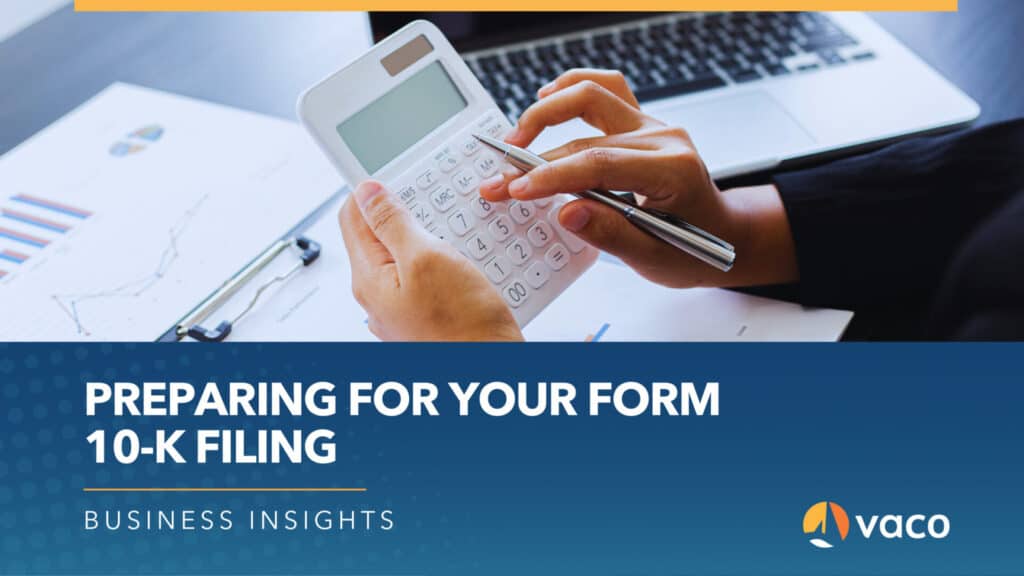It’s that time again…you’ve survived Q3, and the weather is finally getting cooler. You may feel ready to coast through to the holidays. Before you do, however, let’s talk about your company’s annual report on Form 10-K and what you can do now to prepare—so “future you” will be thankful.
1. Review your notes from last year
Dig up your notes from last year, and consult the list of things you swore you’d do differently this year. Don’t have a list? Now is the time to start one. As you navigate the completion of your annual report, make notes of any interdependencies, areas of struggle, or delays.
Utilize your quarterly reports on Form 10-Q to get insights on key things that have happened over the past year. These may accelerate your understanding and ability to communicate your company’s financial story to investors.
2. Meet with department leaders
Schedule meetings with key department heads to get their take on the fiscal year. Make note of any key occurrences or commonly reported incidents, and find out what’s most important to each leader. Note any fresh footnotes you may need to include or discussions in the business section or MD&A.
3. Review your Form 10-K from the prior year
Review your prior year 10-K and see how current year activity will impact what needs to be disclosed. Note any new content you may need to include.
4. Consult EDGAR

Visit the Securities and Exchange Commission’s EDGAR database and read up on your competition and the public companies you admire. Make note of any new things they are disclosing this year—do their filings look “fresh” and more modern? Are they incorporating more graphic illustrations, tables or photos?
Don’t derail yourself at this point trying to do it all in this filing but make a list of things that others are doing and discuss how these fit in with your company’s culture and methodology regarding reporting. Incorporate a few things now if possible. Or take note and begin to incorporate in Q1 next year.
5. Consult recent accounting pronouncements
Read up on any recent accounting pronouncements from the Financial Accounting Standards Board (FASB). Print out the list of Accounting Standards Updates (“ASUs”) issued in 2022 and use it as a checklist or request one from your auditors. Head back to EDGAR and see what your competition is disclosing, then draft that part of your own footnote.
6. Read SEC comment letters
Read up on SEC comment letters written this year on others in your peer group. You can search in EDGAR by CORRESP “file types”. You may also be lucky enough to have a subscription to a service or auditors that will pull them for you, so ask around.
Make a list of SEC comments that are applicable to your company, and make sure to address them so you don’t get the same comment this year.
7. Develop a schedule
By this time, your auditors have probably sent you the dreaded PBC list. Develop your internal calendar of due dates, and be sure to factor in time for the required levels of internal review.
Circulate the list to all relevant parties, and get buy-in on the due dates. Discuss interdependencies, and coordinate early to ensure everyone knows who to ask and where to get the information and supporting documentation they need to meet the deadlines. Remember: other departments outside of accounting will need to get involved, so it’s best to let them know now.
8. Work with your audit team
Ask your audit team for final copies of all memos that need to be updated this year. Don’t rely on the last draft you have on your server; oftentimes, edits are made in the final stages of partner or quality review that you haven’t seen yet. (And it’s usually the difficult things you missed the first time!)
Begin to update these memos now. Ask your audit team if there will be requirements for additional memos based on the occurrences at your company this year. For example, if you have acquired another company, have you documented the methodology for the purchase price allocation and drafted the ASC 805 memo?
9. Start checking off boxes
Ask yourself a few key questions:
- Have you done your goodwill impairment and intangible asset impairment analyses yet?
- Did you issue stock, options, or warrants?
- Do you need to value your acquired intangibles?
- Do you need an outside valuation for anything?
Engage those specialists now.
10. Get on top of reconciliations
Get an update on the status of your account reconciliations. Are they all up to date? What about that one account that’s been keeping the controller up at night?
Come up with a plan to get it done.
11. Document new leadership
Start collecting information on new executives or board members that will be disclosed in the Executive Compensation section of the 10-K (or proxy, if you file it separately).
12. Get things moving
Start rolling forward your 10-K document. Find out from your team if the shell of the F-pages will come from last quarter or from last year’s 10-K.
13. Meet with your SOX team
Set aside time with your SOX team to review the reporting and disclosure controls you’ll be tested on next summer. If your company isn’t large enough to have a dedicated SOX team, make sure you have the documentation you need for an effective control environment.
14. Review your XBRL tagging
Look at your XBRL tagging. Are you making a lot of changes in your 10-K from last year that need tags? Are there new XBRL requirements that need to be adopted? Don’t wait until the night before you file to get clarification on these questions.
15. Submit your request now to enjoy a few days off after your filing deadline!
Is your company fast approaching SEC filing season? Are there gaps on your accounting and reporting team?
Vaco has the expertise and talent network to help you fill out your department and power through your SEC, audit, and year-end close challenges.
Learn more about our accounting and finance solutions or reach out today to find out how we can help you.
About our author

Michelle Goheen is a SEC reporting consultant for Vaco in Los Angeles.

